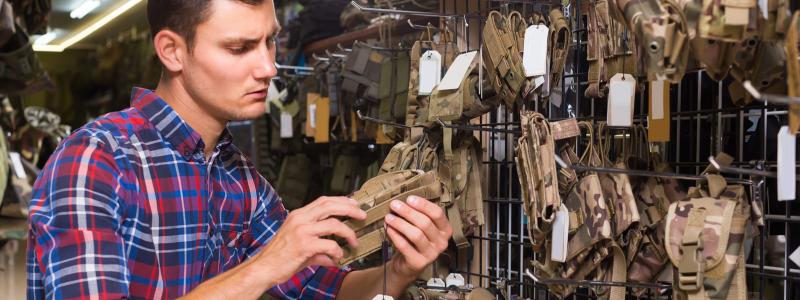Posted 4 years ago


Holsters are generally designed to offer protection to the handgun, secure its retention, and provide ready access to it. The need for ready access is often at odds with the need for security and protection, so the user must consider the individual's needs. Choosing the right balance can be very important, especially in the case of a defensive weapon holster, where failure to access the weapon quickly or damage or loss of the weapon due to insufficient retention or protection could result in serious injury or death to the user.
Holsters are generally designed to be used with one hand, allowing the handgun to be removed and/or replaced with the same hand. To be able to return the handgun to its holster one-handed, the holster must be made from stiff material that holds its shape so that the holster won't collapse when the object is no longer inside to give it support.
Holsters are generally attached to a person's belt or waistband or clipped to another article of clothing. Some holsters, such as ankle holsters, have integrated support. Other holsters may fit inside a pocket, to add stability and protection to the handgun, keeping it more reliably secure and accessible than if it were in the pocket alone.
Holsters are preferably worn in a location where they can be readily accessible. Common locations are: at the waist (outside (OWB) or inside (IWB) the waistband), behind the back (small of back (SOB)), at the ankle, at the chest (in an elastic belly band or shoulder holster), or on the upper thigh. Holsters are sometimes contained in an external bag, such as a purse or fanny pack.
Choosing the right gun holster is about more than pitting IWB versus OWB or shoulder versus drop-leg. It’s also about the type of material the holster is made from, and which type of holster material is best for your needs.
The most common holster materials are synthetic, leather and nylon. Each has its own strengths and weaknesses, and some are right for some jobs and completely wrong for others. This guide gives you the info you need to decide which holster material might be best for you.
When you’re shopping for a holster, look for a combination of durability, security, and ease-of-use based on the way you intend to carry. You’ll need a different holster if you’re working out at the gym, than you’ll need if you’re patrolling, defending your home or running errands in the city – and now that you know what to look for, you can choose the best holster material for your needs.

|
PROS OF SYNTHETIC |
CONS OF SYNTHETIC |
|
Holsters made from Kydex and other polymers don’t lose their shape, even after years of use. |
Drawing your gun from a plastic or Kydex holster can be noisier than drawing from leather or nylon. |
|
There’s no “break-in” period for polymer holsters like there is with leather – although you can mold Synthetic to the specific shape of your gun by adding a little heat. |
Synthetics can wear against the finish on your gun, particularly around edges and corners. |
|
Synthetics are extremely lightweight and less expensive than leather. |

When you think of a gun holster, you probably think of leather first. This is one of the most common materials on the market and for good reason. Leather is naturally long lasting, retains the weapon well with a secure fit, and it looks great for those concerned with style matters. Leather is also quieter than other options, so you can draw your firearm as discreetly as possible. Leather is also undeniably comfortable against the body whereas harder materials can be a bit of nuisance to wear. The only drawback to leather is that it may shrink or loosen its fit over time. It can also crack when left exposed to high heat and sunlight. Aside from that, leather is one of the best solutions on the market for a gun holster.
|
PROS OF LEATHER |
CONS OF LEATHER |
|
Leather holsters are flexible and comfortable, and they form to your body over time. |
Drawing your gun can take a fraction of a second longer than it would with a Synthetic holster simply because of the material’s friction. |
|
Drawing your gun from leather is quiet. |
Leather degrades and provides less support over time. |
|
You can sweat through a leather holster. |

|
PROS OF NYLON |
CONS OF NYLON |
|
Usually the cheapest option. |
May not last as long as other options. High-denier nylon, like the 1050D nylon lasts longer than thinner nylon holster fabric does. |
|
Nylon holsters are considered more ‘universal’ because they’re usually not molded for a particular firearm. |
Less structure often means less security and structural integrity. |
|
Drawing from a nylon holster can be whisper-quiet. |
OWB and IWB configuration options can sometimes be tricky. |
When you want the best of both leather and synthetic, there are hybrids. These options use leather as the main element of construction for the exterior yet utilize a synthetic holster interior designed so you never have to choose between the two. When you can’t decide between a leather or synthetic because they both have great benefits to offer, maybe a hybrid is your best bet.